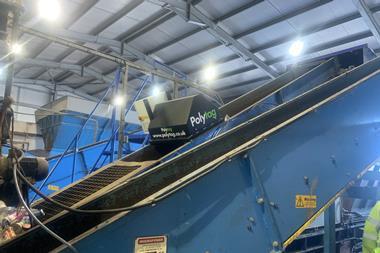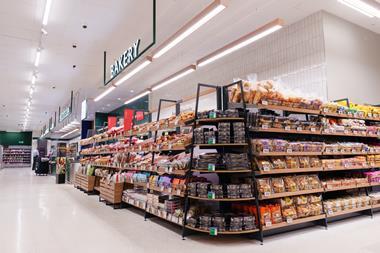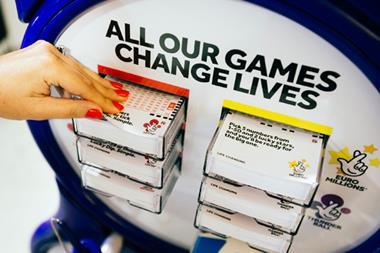Pushing out the frontiers
Waitorse is boldly seeking out new markets in new areas. Director of development and services Nigel Burton outlines the mission to Gillian Law
Take away all the food from your local Waitrose and pile it up in the street outside what you have left is Nigel Burton's responsibility.
The building, the car park, the shelves, the cabinets and the light switches, even the bread slicer and the newly designed uniforms, all fall into Burton's remit as director of development and services. He's a busy man.
Since joining Waitrose in 1992, Burton has been responsible for the opening of 30 branches, with another 15 to come this year. His team has also refitted 100 or so stores and extended 23 to turn them into full-size, 25,000 sq ft supermarkets.
His first job was daunting and had been planned before he even got there organising a total refit and redesign of the stores.
"We did a facelift, changed the colour scheme from orange to green and cream, then put in scanning systems, which we hadn't had before," Burton says. "The result was an impressive increase in turnover and I think that gave us the confidence to move forward in the development programme."
Waitrose usually builds its own stores, but this year it has bought 11 Somerfield supermarkets and is converting them to its own designs. The process is slower and harder, says Burton, "because there's an existing business that you have to keep going while you manage the changeover. We need to refit them and make them look like Waitrose without losing the local shoppers."
He adds: "So the challenge is to shut for as short a time as possible we're aiming for six or seven weeks at most."
In those weeks, Burton's teams have to put in new colour schemes, fixtures, service counters for products such as fish, cheese and patisserie, plus new checkouts because Somerfield uses a different EPoS system.
Burton won't give precise figures for the refurb costs but says that the refit at some stores will cost about £1m.
On the newbuild side, Burton says there's no such thing as a greenfield site with today's planning regulations.
Councils now demand that stores are opened in brownfield sites, which are often much smaller and involve several land transactions in one purchase, currently being managed, Waitrose must buy land from 23 different owners.
But Waitrose has an advantage over its competitors, says Burton, in that it has always tended to build in towns.
"We know how to make compromises, how to put the services in the basement, the warehouse on the first floor and partner accommodation on the second, for example," he says. "That's all new to our competitors."
Local authorities are also quite open to the idea of a Waitrose store, he says, "because we're different to the other supermarkets, which are everywhere".
On the services side, Burton has a team of people who source fittings and equipment and keep the stores kitted out and running.
"I have one chap whose sole role is to travel the world finding new ideas and telling us the type of cabinets, for example, we should be using," Burton says. "Lovely job he has."
Other staff work with the merchandising and design departments to choose the best products from Britain or overseas. Waitrose does try to buy British, says Burton, "but we buy the best, wherever we can get it".
Service managers around the country run teams of tradesmen who look after the stores, doing plumbing or electrical work anything that's necessary.
They're all employed by Waitrose, because you get much better work that way, says Burton. "We looked at contracting it out but it's cheaper this way and these people are committed," he says. "They're up at 4am if there's a fridge alarm."
Looking forward, Burton predicts further expansion and an ongoing effort to keep stores fresh and up to date. He can't foresee another major refit like the one that took place when he started; Waitrose has got it about right now, he thinks, and just needs to keep on top of things.
Nor are there any geographical boundaries to where the stores can go with shops in Cornwall, Norwich and Sudbury, Waitrose's reach is growing.
The company will go wherever there's a market for its products. A research team within John Lewis and a smaller Waitrose team provide demographic information on possible sites. "It starts off with a gut feeling," Burton says. "After this many years in the business, you know what a Waitrose town feels like. But then we need the figures to prove it should go ahead."
{{Z SUPPLEMENTS }}
Close menu
- Home
- Retail & Wholesale
-
Products & Suppliers
- Back to parent navigation item
- Products & Suppliers
-
Product Categories:
- Back to parent navigation item
- Product Categories:
- Alcoholic drinks
- Bakery
- Cereals & breakfast
- Cheese
- Chicken & poultry
- Chocolate
- Confectionery
- Crisps, nuts & snacks
- Dairy
- Fish
- Fresh produce
- Frozen
- Household
- Meat
- Own Label
- Sauces & condiments
- Seasonal
- Soft drinks
- Vaping
- Vegan & plant-based
- World foods
- Suppliers
- People
- Reports & Data
-
Topics A-Z
- Back to parent navigation item
- Topics A-Z
-
Popular topics:
- Back to parent navigation item
- Popular topics:
- Cost of living crisis
- Crime
- Deposit Return Schemes
- Finance
- Government & Regulation
- Health
- Inflation
- Loyalty
- Marketing
- Mergers & Acquisitions
- New Product Development
- Sourcing
- Supply chain
- Sustainability & environment
- Technology
- Ultra Processed Foods
- Vaping
- A-Z all topics
- Content by type:
- Events
- Ask iA (beta)
- Subscribe now
Sign in to comment on this article
Not logged in before? Register for FREE guest access today.
You will be able to:
- Read more stories
- Receive daily newsletters
- Comment on stories
Advert



















No comments yet